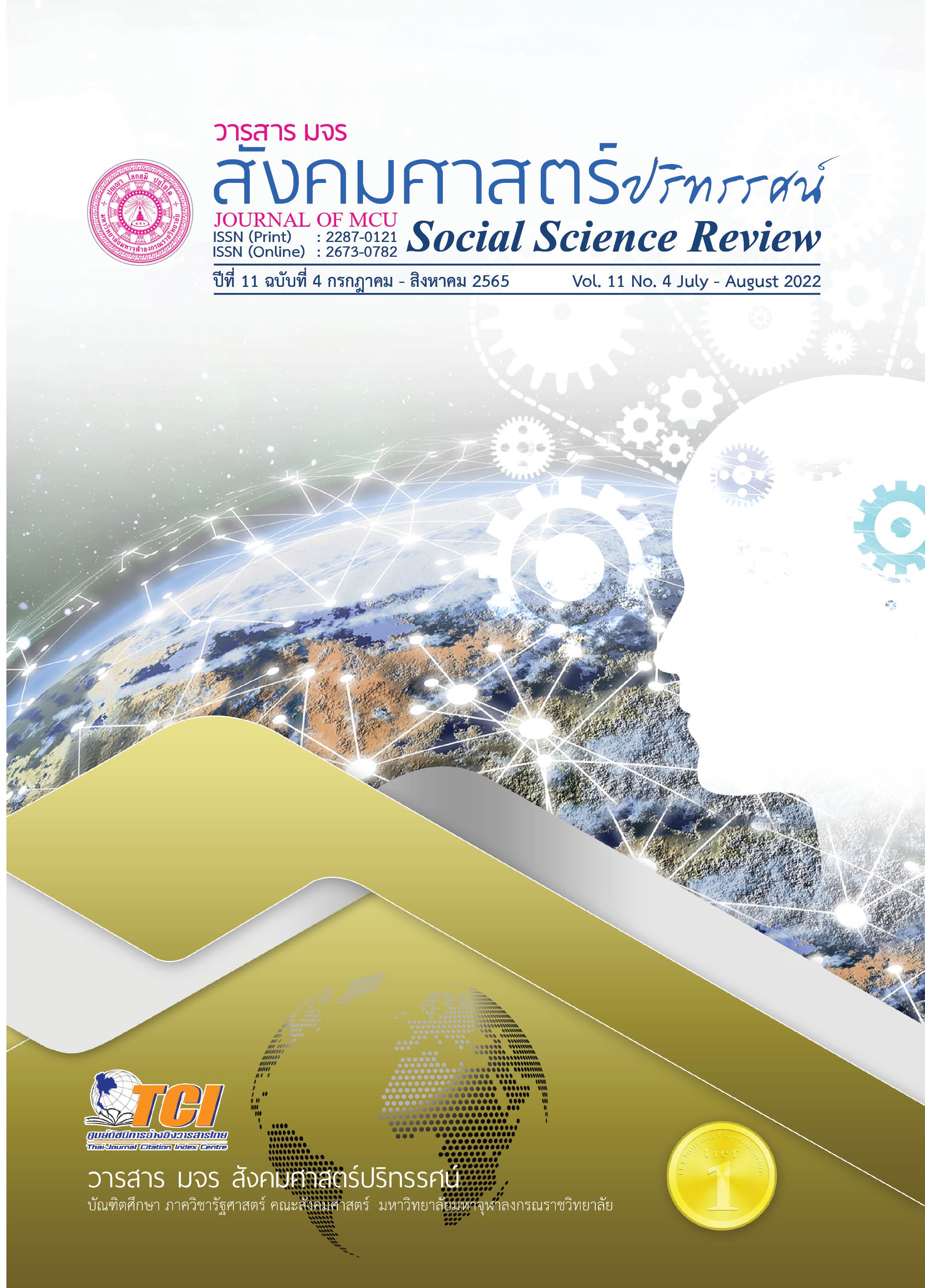การพัฒนาวัดเพื่อการท่องเที่ยวเชิงเกษตรในจังหวัดอ่างทอง
คำสำคัญ:
การพัฒนาวัด, การท่องเที่ยว, การท่องเที่ยวเชิงเกษตรบทคัดย่อ
บทความวิจัยนี้มีวัตถุประสงค์เพื่อศึกษาสภาพทั่วไป องค์ประกอบในการพัฒนาวัด และนำเสนอแนวทางการพัฒนาวัด เป็นการวิจัยแบบผสานวิธี ประกอบด้วยการวิจัยเชิงปริมาณ เป็นการวิจัยเชิงสำรวจจากแบบสอบถามกับพระสงฆ์จังหวัดอ่างทอง 314 รูป สถิติที่ใช้ในการวิจัย คือ ค่าความถี่ ค่าร้อยละ ค่าเฉลี่ย ค่าเบี่ยงเบนมาตรฐาน และการวิจัยเชิงคุณภาพเก็บข้อมูลด้วยการสัมภาษณ์เชิงลึกกับผู้ให้ข้อมูลสำคัญ จำนวน 8 รูปหรือคน วิเคราะห์ข้อมูลเชิงพรรณนาเรียบเรียงและจำแนกอย่างเป็นระบบ
ผลวิจัยพบว่า 1. สภาพทั่วไปใน จุดแข็ง วัดส่วนใหญ่มีพื้นที่กว้าง ตั้งอยู่ในแหล่งของชุมชนการเกษตร จุดอ่อน เป็นพื้นที่ธรณีสงฆ์ โอกาส การท่องเที่ยวเชิงเกษตร ได้รับความนิยม อุปสรรค สนับสนุนจากภาครัฐมีน้อย 2. องค์ประกอบในการพัฒนาวัด คือ วางคนให้ตรงกับงาน ทันต่อเหตุการณ์โลก มีนโยบายและพันธกิจในการทำงานที่ชัดเจน มีการจัดเตรียมงบประมาณให้เพียงพอ มีการวางแผนใช้งบประมาณ มีวัสดุอุปกรณ์ที่ครบพร้อมเพรียงที่จะใช้งาน มีการวางระบบการจัดการ การวางแผนงาน 3. แนวทางการพัฒนาวัด ควรพัฒนาให้มีความปลอดภัยเป็นระเบียบ ควรมีสิ่งอำนวยความสะดวกที่เป็นพื้นฐานให้ครบครัน มีการจัดเก็บข้อมูลที่ครบถ้วน มีเทคโนโลยีสารสนเทศในการช่วยเผยแพร่ข้อมูล วัดเป็นศูนย์การเรียนรู้ ประยุกต์ใช้วิถีชุมชน มีการจัดอบรมฝึกอบรมบุคลากรให้มีความรู้เกษตร มีการจัดทำแผนงบประมาณ มีงบประมาณในการประชาสัมพันธ์ส่งเสริม ประยุกต์ใช้เทคโนโลยีเพื่อช่วยในการใช้ในการทำการเกษตร ควรมีการสร้างเครือข่ายชุมชนดำเนินการพัฒนาวัด
เอกสารอ้างอิง
กรมการท่องเที่ยว. (2557). คู่มือการประเมินแหล่งท่องเที่ยวเชิงเกษตร (พิมพ์ครั้งที่ 2). กรุงเทพฯ: สำนักงานกิจการโรงพิมพ์องค์การสงเคราะห์ทหารผ่านศึกในพระบรมราชูปถัมภ์.
ณัฏฐพงษ์ ฉายแสงประทีป. (2557). รูปแบบและกระบวนการดำเนินธุรกิจการท่องเที่ยวเชิงเกษตร. Veridian E Journal สาขามนุษยศาสตร์ สังคมศาสตร์ และศิลปะ, 7(3), 310-321.
ดลใจ มณีงาม. (2550). พฤติกรรมและความพึงพอใจของผู้มาเที่ยวที่มีต่อการบริหารจัดการสถานที่ท่องเที่ยวในจังหวัดพระนครศรีอยุธยา (วิทยานิพนธ์บริหารธุรกิจมหาบัณฑิต สาขาการจัดการทั่วไป). พระนครศรีอยุธยา: มหาวิทยาลัยราชภัฏพระนครศรีอยุธยา.
ปิยะวดี หิริมกมล. (2545). พฤติกรรมการท่องเที่ยวของนักท่องเที่ยวชาวไทยต่อการท่องเที่ยวในจังหวัดสุโขทัย. กรุงเทพฯ: มหาวิทยาลัยสุโขทัยธรรมาธิราช.
พระครูพิทักษ์ศิลปาคม (นุชิต วชิรวุฑฺโฒ). (2561) การพัฒนาวัดเพื่อการท่องเที่ยวเชิงวัฒนธรรมในอำเภอโพธารามจังหวัดราชบุรี (สารนิพนธ์พุทธศาสตรมหาบัณฑิต สาขาวิชาการจัดการเชิงพุทธ). พระนครศรีอยุธยา: มหาวิทยาลัยมหาจุฬาลงกรณราชวิทยาลัย.
พระมหาธัชธร สิริมงฺคโล (มาตรา). การจัดการการท่องเที่ยวเชิงพุทธของวัดหนองแวง (พระอารามหลวง) อำเภอเมือง จังหวัดขอนแก่น. (พุทธศาสตรมหาบัณฑิต สาขาวิชารัฐประศาสนศาสตร์). พระนครศรีอยุธยา: มหาวิทยาลัยมหาจุฬาลงกรณราชวิทยาลัย.
มหาจุฬาลงกรณราชวิทยาลัย. (2539). พระไตรปิฎกฉบับภาษาไทย ฉบับมหาจุฬาลงกรณราชวิทยาลัย. กรุงเทพฯ: โรงพิมพ์มหาจุฬาลงกรณราชวิทยาลัย.
สุวรีย์ ศิริโภคาภิรมย์. (2546) การวิจัยทางการศึกษา. ลพบุรี: ฝ่ายเอกสารการพิมพ์สถาบันราชภัฎเทพสตรี.
สำนักงานเจ้าคณะจังหวัดอ่างทองอำเภอ. (2563). บัญชีสำรวจพระภิกษุ สามเณร, ชี, ศิษย์วัด, อารามิกชน ประจำปี พ.ศ. 2563 คณะสงฆ์จังหวัดอ่างทอง. อ่างทอง: สำนักงานเจ้าคณะจังหวัดอ่างทอง.
อนัญญา ปาอนันต์. (2560) แนวทางการส่งเสริมการท่องเที่ยวเชิงเกษตร จังหวัดระยอง (วิทยานิพนธ์ศิลปะศาสตรมหาบัณฑิต สาขาวิชาพระพุทธศาสนา) กรุงเทพฯ: มหาวิทยาลัยธุรกิจบัณฑิต.
ดาวน์โหลด
เผยแพร่แล้ว
รูปแบบการอ้างอิง
ฉบับ
ประเภทบทความ
สัญญาอนุญาต
ลิขสิทธิ์ (c) 2022 วารสาร มจร สังคมศาสตร์ปริทรรศน์

อนุญาตภายใต้เงื่อนไข Creative Commons Attribution-NonCommercial-NoDerivatives 4.0 International License.
เพื่อให้เป็นไปตามกฎหมายลิขสิทธิ์ ผู้นิพนธ์ทุกท่านต้องลงลายมือชื่อในแบบฟอร์มใบมอบลิขสิทธิ์บทความให้แก่วารสารฯ พร้อมกับบทความต้นฉบับที่ได้แก้ไขครั้งสุดท้าย นอกจากนี้ ผู้นิพนธ์ทุกท่านต้องยืนยันว่าบทความต้นฉบับที่ส่งมาตีพิมพ์นั้น ได้ส่งมาตีพิมพ์เฉพาะในวารสาร มจร สังคมศาสตร์ปริทรรศน์ เพียงแห่งเดียวเท่านั้น หากมีการใช้ภาพหรือตารางหรือเนื้อหาอื่นๆ ของผู้นิพนธ์อื่นที่ปรากฏในสิ่งตีพิมพ์อื่นมาแล้ว ผู้นิพนธ์ต้องขออนุญาตเจ้าของลิขสิทธิ์ก่อน พร้อมทั้งแสดงหนังสือที่ได้รับการยินยอมต่อบรรณาธิการ ก่อนที่บทความจะได้รับการตีพิมพ์ หากไม่เป็นไปตามข้อกำหนดเบื้องต้น ทางวารสารจะถอดบทความของท่านออกโดยไม่มีข้อยกเว้นใดๆ ทั้งสิ้น





